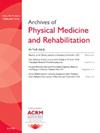慢性脑损伤护理模式。
IF 3.6
2区 医学
Q1 REHABILITATION
Archives of physical medicine and rehabilitation
Pub Date : 2025-01-01
DOI:10.1016/j.apmr.2024.08.001
引用次数: 0
摘要
越来越多的证据表明,创伤性脑损伤(TBI)后的长期疗效与其说是稳定的,不如说是动态的。人在受伤后多年仍在不断变化,既有改善,也有衰退。研究、实践和医学教育尚未充分认识到创伤性脑损伤是一种慢性、动态的疾病。2020 年,美国国家残疾人独立生活和康复研究所资助了 BeHEALTHY 项目,以开发一种为慢性脑损伤患者提供长期支持的模式。根据对现有证据的初步审查以及来自研究人员、临床医生和有生活经验者的专家意见,提出了 BeHEALTHY 模式。在现有的慢性病治疗模式中,我们选择了瓦格纳的慢性病护理模式作为起点,并对其进行了一些重要的改进。BeHEALTHY 模式支持以人为本的方法,承认脑损伤患者及其社会支持系统是护理规划目标的主要来源。该模式还承认自我管理的极端重要性,以及医疗保健计划需要积极促进患者利用其社会支持进行自我指导。该模式还认识到,治疗效果不仅取决于患者本人和所受的伤害,还取决于患者的生活和康复环境。将环境影响作为社区和医疗保健系统的共同责任,强调了将医疗保健与社区资源相结合的重要性。本文叙述了开发 BeHEALTHY 模式的动机,并介绍了该模式的服务对象、结构特征和核心组成部分。本文章由计算机程序翻译,如有差异,请以英文原文为准。
Model of Care for Chronic Brain Injury
There is growing evidence that long-term outcomes after traumatic brain injury (TBI) are more dynamic than stable. People continue to change, both improving and declining, many years postinjury. Research, practice, and medical education have not yet fully embraced the implications of TBI as a chronic, dynamic condition. In 2020, the National Institute on Disability Independent Living and Rehabilitation Research funded the BeHEALTHY project to develop a model for long-term support of persons with chronic brain injury. Based on initial reviews of the available evidence and expert input from researchers, clinicians, and persons with lived experience, the BeHEALTHY model was proposed. Among existing chronic disease treatment models, Wagner's Chronic Care Model was selected as a starting point, with several critical refinements. The BeHEALTHY model endorses a person-centered approach, recognizing the individual with brain injury, and their social support system, as the primary source of goals in care planning. The model also acknowledges the critical importance of self-management and the need for health care programs to actively promote self-direction by the person using their social supports. The model also recognizes that outcomes are not determined solely by the person and the injury incurred but also by the environment in which a person lives and recovers. The importance of integrating health care with community resources is underscored by embracing environmental influences as a shared responsibility of the community and the health care system. This article recounts the impetus for developing the BeHEALTHY model and describes those it is intended to serve and its structural features and core components.
求助全文
通过发布文献求助,成功后即可免费获取论文全文。
去求助
来源期刊
CiteScore
6.20
自引率
4.70%
发文量
495
审稿时长
38 days
期刊介绍:
The Archives of Physical Medicine and Rehabilitation publishes original, peer-reviewed research and clinical reports on important trends and developments in physical medicine and rehabilitation and related fields. This international journal brings researchers and clinicians authoritative information on the therapeutic utilization of physical, behavioral and pharmaceutical agents in providing comprehensive care for individuals with chronic illness and disabilities.
Archives began publication in 1920, publishes monthly, and is the official journal of the American Congress of Rehabilitation Medicine. Its papers are cited more often than any other rehabilitation journal.

 求助内容:
求助内容: 应助结果提醒方式:
应助结果提醒方式:


